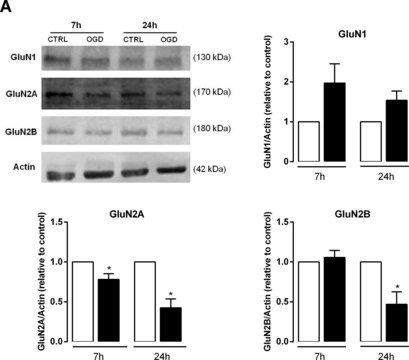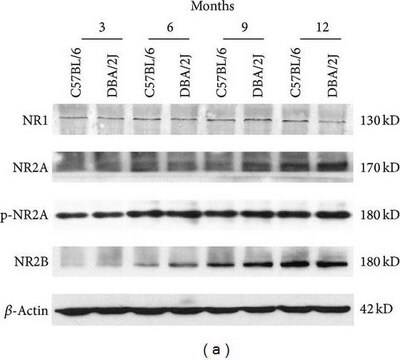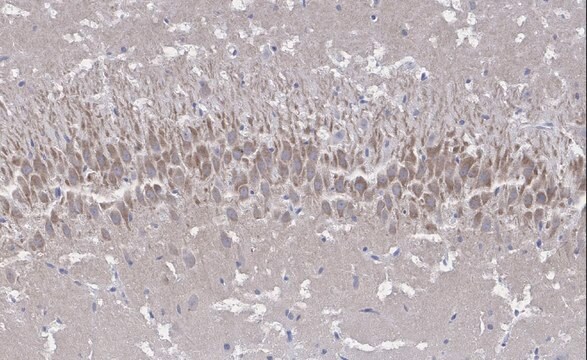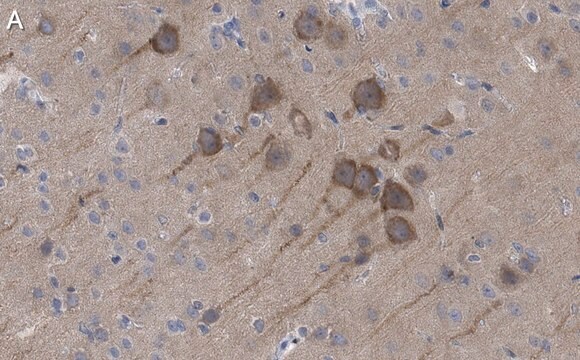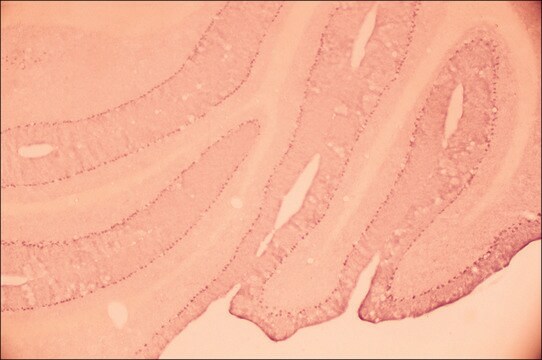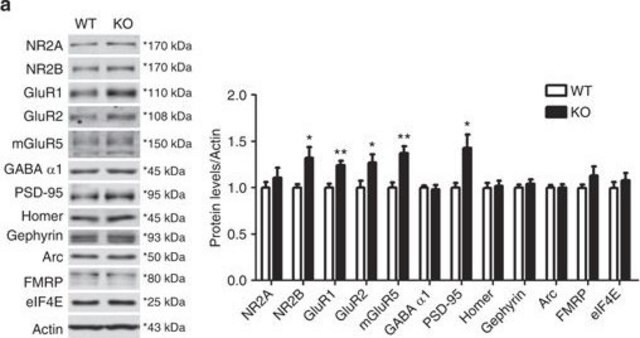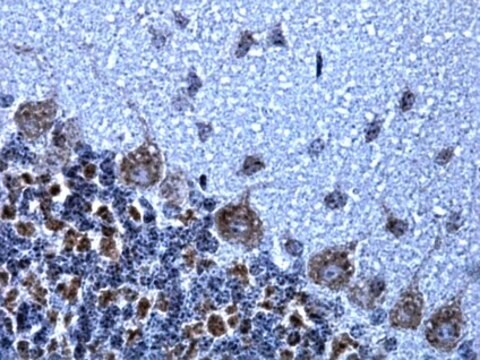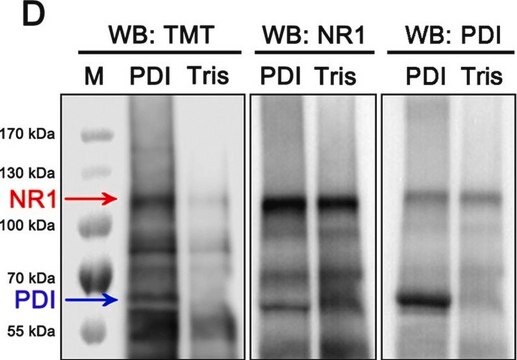AB1557P
Anti-NMDAR2B Antibody
Chemicon®, from rabbit
동의어(들):
N-methyl D-aspartate receptor subtype 2B, N-methyl-D-aspartate receptor subunit 2B, N-methyl-D-aspartate receptor subunit 3, glutamate receptor subunit epsilon-2, glutamate receptor. ionotropic, N-methyl D-aspartate 2B, Glutamate
로그인조직 및 계약 가격 보기
모든 사진(1)
About This Item
UNSPSC 코드:
12352203
eCl@ss:
32160702
NACRES:
NA.41
추천 제품
생물학적 소스
rabbit
Quality Level
항체 형태
affinity isolated antibody
항체 생산 유형
primary antibodies
클론
polyclonal
종 반응성
mouse, rat, human
제조업체/상표
Chemicon®
기술
immunohistochemistry: suitable
immunoprecipitation (IP): suitable
western blot: suitable
NCBI 수납 번호
UniProt 수납 번호
배송 상태
dry ice
타겟 번역 후 변형
unmodified
일반 설명
NMDA receptors are a class of ionotropic glutamate receptors. NMDA receptor channel has been shown to be involved in long term potentiation, an activity dependent increase in the efficiency of synaptic transmission thought to underlie certain kinds of memory and learning. NMDA receptor channels are heteromers composed of the key receptor subunit NMDAR1 (GRIN1) and 1 or more of the 4 NMDAR2 subunits: NMDAR2A (GRIN2A), NMDAR2B (GRIN2B), NMDAR2C (GRIN2C), and NMDAR2D (GRIN2D). GRIN2B may be a candidate gene for the neurodegenerative disorder dentato-rubro-pallidoluysian atrophy (DRPLA).
Properties of NMDAR include modulation by glycine, inhibition by Zn2+, voltage dependent Mg2+ blockade and high Ca2+ permeability. The involvement of NMDAR in the CNS has become a focus area for neurodegenerative diseases such as Alzheimer′s disease and also epilepsy and ischemic neuronal cell death.
Properties of NMDAR include modulation by glycine, inhibition by Zn2+, voltage dependent Mg2+ blockade and high Ca2+ permeability. The involvement of NMDAR in the CNS has become a focus area for neurodegenerative diseases such as Alzheimer′s disease and also epilepsy and ischemic neuronal cell death.
특이성
NMDAR2B. Strong and specific immunolabeling of the 180 kDa NMDAR2B subunit of the NMDA receptor. No reactivity to NMDAR2A or NMDAR2C by Western blot. Immunolabeling has been blocked by preadsorption of the antibody with the C-terminal fusion protein that was used to generate the antibody.
면역원
C-Terminal Fusion Protein of the NMDAR2B (30 kDa).
Epitope: C-terminus
애플리케이션
Anti-NMDAR2B Antibody is an antibody against NMDAR2B for use in IH, IP & WB.
Immunohistochemistry:
1:1,000-1:2,000 dilution of a previous lot was used on immunohistochemistry.
Immunoprecipitation:
3 μL of a previous lot of this antibody (under appropriate conditions) quantitatively immunoprecipitated all NMDAR2B in 200 μg of rat brain.
Western Blot Analysis:
1:100-1:2,000 dilution of a previous lot (NMDAR2B is present in high concentrations in the hippocampus).
Optimal working dilutions must be determined by the end user.
1:1,000-1:2,000 dilution of a previous lot was used on immunohistochemistry.
Immunoprecipitation:
3 μL of a previous lot of this antibody (under appropriate conditions) quantitatively immunoprecipitated all NMDAR2B in 200 μg of rat brain.
Western Blot Analysis:
1:100-1:2,000 dilution of a previous lot (NMDAR2B is present in high concentrations in the hippocampus).
Optimal working dilutions must be determined by the end user.
Research Category
Neuroscience
Neuroscience
Research Sub Category
Neurotransmitters & Receptors
Neurotransmitters & Receptors
표적 설명
180 kDa
물리적 형태
Format: Purified
ImmunoAffinity Purified
Purified rabbit polyclonal lyophilized from ammonium bicarbonate (5 mM). Some residual salt may also be present. Reconstitute with 50 μL of PBS. Contains no preservatives.
저장 및 안정성
Stable for 1 year at -20ºC from date of receipt.
분석 메모
Control
Brain tissue, Rat Purkinje cell dendrites, rat hippocampus lysate, HEK 293 cells expressing NR2B.
Brain tissue, Rat Purkinje cell dendrites, rat hippocampus lysate, HEK 293 cells expressing NR2B.
기타 정보
Concentration: Please refer to the Certificate of Analysis for the lot-specific concentration.
법적 정보
CHEMICON is a registered trademark of Merck KGaA, Darmstadt, Germany
면책조항
Unless otherwise stated in our catalog or other company documentation accompanying the product(s), our products are intended for research use only and are not to be used for any other purpose, which includes but is not limited to, unauthorized commercial uses, in vitro diagnostic uses, ex vivo or in vivo therapeutic uses or any type of consumption or application to humans or animals.
적합한 제품을 찾을 수 없으신가요?
당사의 제품 선택기 도구.을(를) 시도해 보세요.
Storage Class Code
11 - Combustible Solids
WGK
WGK 1
시험 성적서(COA)
제품의 로트/배치 번호를 입력하여 시험 성적서(COA)을 검색하십시오. 로트 및 배치 번호는 제품 라벨에 있는 ‘로트’ 또는 ‘배치’라는 용어 뒤에서 찾을 수 있습니다.
Long-term potentiation in the hippocampal CA1 area and dentate gyrus plays different roles in spatial learning.
Takashi Okada, Nobuaki Yamada, Keisuke Tsuzuki, Hiroshi P M Horikawa, Kohichi Tanaka, Seiji Ozawa
The European Journal of Neuroscience null
Functional NMDA receptor channels generated by NMDAR2B gene transfer in rat cerebellar Purkinje cells.
Wataru Kakegawa, Keisuke Tsuzuki, Masae Iino, Seiji Ozawa
The European Journal of Neuroscience null
Q Liu et al.
Neuroscience, 171(3), 637-654 (2010-10-05)
Previously, we reported that a critical period in respiratory network development exists in rats around postnatal days (P; P12-P13), when abrupt neurochemical, metabolic, and physiological changes occur. Specifically, the expressions of glutamate and N-methyl-d-aspartate (NMDA) receptor (NR) subunit 1 in
A M Khan et al.
The Journal of comparative neurology, 428(3), 428-449 (2000-11-14)
Glutamate (Glu), a major excitatory neurotransmitter within the hypothalamus and thalamus, acts upon many receptors, including the N-methyl-D-aspartate (NMDA) subtype. Abundant evidence suggests that variations in the subunit composition of NMDA receptors (NMDA-Rs) contribute to differences in Glu's immediate electrophysiological
M C Currás-Collazo et al.
The Journal of comparative neurology, 427(1), 93-108 (2000-10-24)
Previous studies suggest that activation of N-methyl-D-aspartate (NMDA) receptors facilitates phasic firing and spike clustering displayed by magnocellular neuroendocrine cells (MNCs) of the supraoptic (SON) and paraventricular nucleus of the hypothalamus (PVN). Osmotic stimulation produces similar activity patterns which, in
자사의 과학자팀은 생명 과학, 재료 과학, 화학 합성, 크로마토그래피, 분석 및 기타 많은 영역을 포함한 모든 과학 분야에 경험이 있습니다..
고객지원팀으로 연락바랍니다.